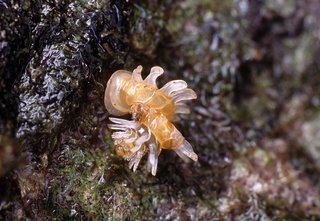Endangered Borneo land snails give glimpse on evolution
 Trumpet-like shells with spines and bizarrely twisted and knotted coils... Opisthostoma snails from Borneo are famous among biologists for their unconventional shapes. They are also in danger because the habitat they depend on (limestone outcrops in the rainforest), is disappearing fast. Now, biologists have discovered that these snails, if they can be conserved, might teach us a thing or two about evolution.
Trumpet-like shells with spines and bizarrely twisted and knotted coils... Opisthostoma snails from Borneo are famous among biologists for their unconventional shapes. They are also in danger because the habitat they depend on (limestone outcrops in the rainforest), is disappearing fast. Now, biologists have discovered that these snails, if they can be conserved, might teach us a thing or two about evolution.The team of Malaysian and Dutch biologists, led by Menno Schilthuizen of Universiti Malaysia Sabah, looked at Opisthostoma snails on thirteen isolated limestone outcrops along the Kinabatangan River in Sabah, Malaysian Borneo. (This area is better known for its larger wildlife, in particular its large orangutan population, subject of the local Kinabatangan Orangutan Conservation Project, which supported the snail study.) Their results are published in the September issue of Evolution.
They found that, even though the hills were sometimes a stone’s throw distance from each other, the snails on each of them had different shells. Conventional theory says that this is because the isolated populations had genetically "drifted apart" over the millions of years that they have lived there. But when the researchers looked at the snails' DNA, they found something different: populations that had drifted far apart in their DNA often had similar shells, whereas populations with very different shells often were almost identical in their DNA. So there was another factor at play.
 That factor revealed itself unexpectedly when Schilthuizen and team members Badul bin Elahan and Angelique van Til started studying the snails' predators. When visiting the limestone hills at night, they came across Opisthostoma’s worst nightmare: a tiny slug that appears from cracks in the rocks at night and scrapes holes in Opisthostoma shells to get at its occupant. And it also appeared that the slugs have different table manners on different hills. On the Gomantong hill, for example, they scrape holes in the tips of the shells, whereas on the hill Tandu Batu, just 30 km downstream, they prefer to delve their teeth in it from below.
That factor revealed itself unexpectedly when Schilthuizen and team members Badul bin Elahan and Angelique van Til started studying the snails' predators. When visiting the limestone hills at night, they came across Opisthostoma’s worst nightmare: a tiny slug that appears from cracks in the rocks at night and scrapes holes in Opisthostoma shells to get at its occupant. And it also appeared that the slugs have different table manners on different hills. On the Gomantong hill, for example, they scrape holes in the tips of the shells, whereas on the hill Tandu Batu, just 30 km downstream, they prefer to delve their teeth in it from below.When the researchers then went back to their shell measurements, they realised that this had been the missing bit of the puzzle: the unorthodox shell adornments were defences against the local manner of slug attack. The results show that new species can form on such a small spatial scale (the study area is just 10 by 35 km) by adaptation to the local environment.
"It is a veritable evolution's workshop," Schilthuizen says.
Unfortunately, the limestone hills of Borneo are vulnerable. The droughts and fires that have been plaguing the island over the past decades have destroyed the vegetation on many of them, and there are plans to quarry some for cement. The researchers hope that their work will show that if you've seen one limestone hll, you've not seen them all.
"If you have the eye for it," says Schilthuizen, "this is one of nature's great experiments on a miniature scale."
[Photographic credits. Top: Nine species of Opisthostoma from Borneo. Artist: Jaap J. Vermeulen. Below: Live specimen of O. fraternum from Sukau, Malaysia. Photo: Peter Koomen.]